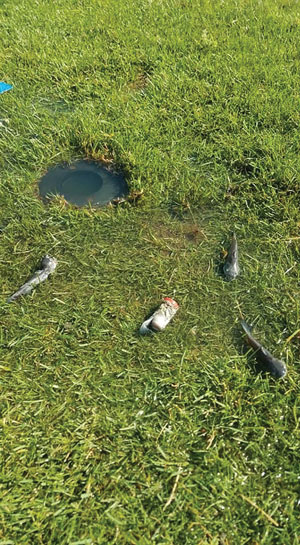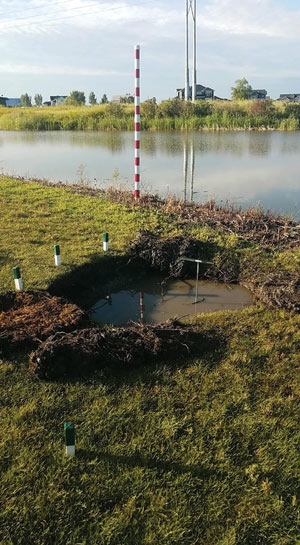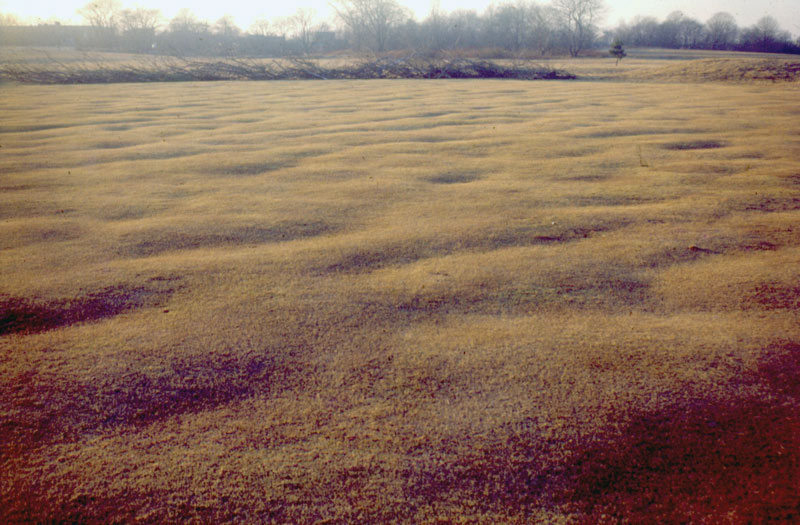GCM’s Photo Quiz is presented in partnership with STEC Equipment.

Problem A: Catfish in irrigation line


Location: Fargo, N.D.
Turfgrass area: Edge of fairway near a pond
Turfgrass variety: Bluegrass/fescue mix
Problem B: Uneven ground

Location: Garden City, N.Y.
Turfgrass area: Putting green
Turfgrass variety: Bentgrass/Poa annua
Scroll down for answers.
Problem A: Catfish in irrigation line
The catfish in this irrigation line are not the result of an issue with an intake screen in an irrigation pond filled with catfish, as you may have guessed. Instead, what happened here can be traced to an irrigation break that occurred right next to a pond with a good supply of catfish.
The break occurred overnight and left water running for about 12 hours, which washed the soil from the break into the pond and created a tunnel that the catfish used to swim upstream and explore. When the pumps were turned off, some of the catfish in the newly created channel swam into the open irrigation pipe for some additional exploration.
When the crew dug into the area where the leak had occurred and drained it, they discovered most of the hole had been dug for them with the irrigation water. They also found some dead catfish in the hole, which they thought was odd.
Once they fixed the break and charged up the system, the fish remaining in the lines got pushed to the dead ends of the lateral line where the break had occurred and clogged up the irrigation heads. It took about a week of head-scratching before the superintendent and his crew figured out what had happened, as they’d had no issues with catfish in the irrigation lines anywhere else on the golf course.
Photo submitted by Victor Heitkamp, the GCSAA Class A superintendent at Osgood Golf Course, a part of the Fargo (N.D.) Park District, and a 20-year GCSAA member.
Problem B: Uneven ground
This photo was taken many years ago and was passed along by retired superintendent and former GCSAA president Mel Lucas, CGCS Retired. A thick layer of clay below the surface of this green was the culprit behind the heaving and resulting damage, which had been an issue on this particular green since March 1899 — one that membership had gradually learned to ignore.
After his first winter at the course, in 1967, the superintendent was stunned by the damage he saw in spring. A number of soil samples he pulled revealed that clay was 18 inches below the surface of the green. As the cycle of freezing and thawing took place, the green would largely settle; however, close mowing would create small scalp marks that required extra topdressing. When the course was built, more than 7½ acres had been quarried in order to use clay to build the village roads. This green, the 14th, sat at the final edge of excavation.
In 1974, the superintendent redesigned the area, removing the native soil and excavating 4 feet of solid clay. The area was filled with a local subsoil, which drained well, and the native soil was modified with sand and replaced, as were the bunkers. After the renovation, the course never experienced any additional issues.
Photo submitted by Mel Lucas, CGCS Retired, an international turfgrass consultant and former golf course superintendent. A 58-year member of GCSAA, Lucas served as association president in 1980.
Editor’s note: Have a photo for Photo Quiz? Email it to author John Mascaro.
John Mascaro is the president of Turf-Tec International.